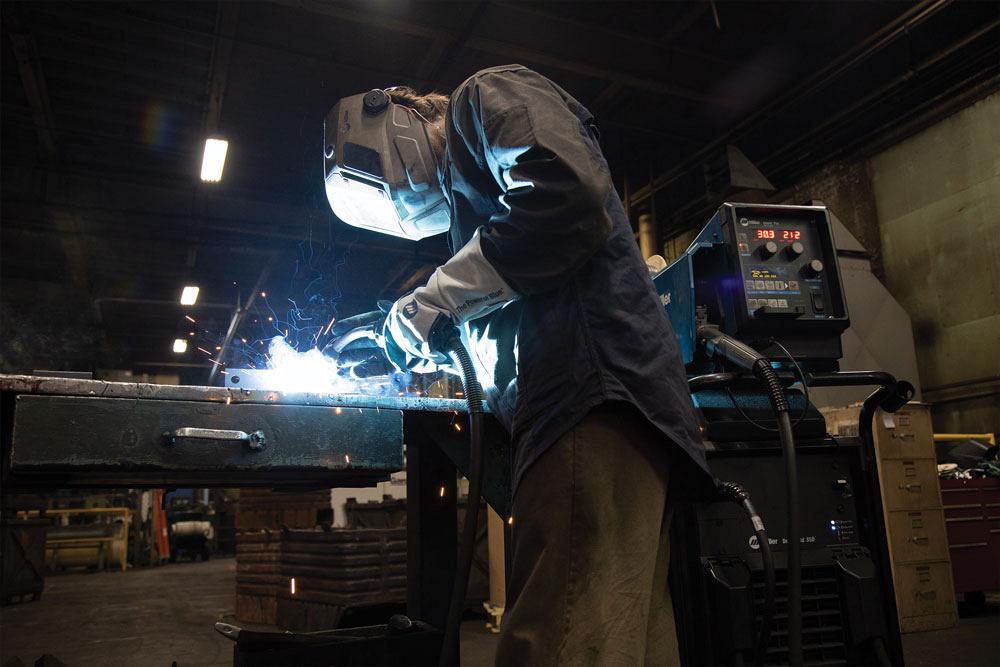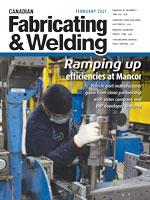Lead welding engineer, CWI - applications
- FMA
- The Fabricator
- FABTECH
- Canadian Metalworking
Choosing your shielding gas profile
Shielding gas choices have a big impact on filler metal performance, so make sure you choose carefully
- By Tre' Heflin-King
- Updated February 16, 2021
- February 19, 2021
- Article
- Welding
Achieving the ideal weld involves a combination of factors: the quality of the base material, welding wire choices, welding procedures, and shielding gases. Creating an environment of efficiency, effectiveness, and employee comfort is important, but the ultimate goal is creating a weld that can withstand the service conditions it will be subject to without the risk of cracking or other failures.
Shielding gas choice directly affects welding performance. It can alter how smoothly the wire welds, spatter levels, and arc qualities. It also can have an impact on the mechanical properties of the final weld.
Understanding shielding gas options and how each alters the process and final weld will help you understand what combination of gases will likely work best for your job.
Shielding Gas Basics
The primary purpose of shielding gases used with solid, gas-shielded flux-cored, or metal-cored wire is to protect the molten weld pool against elements in the atmosphere, such as nitrogen and hydrogen. The infiltration of these external elements in the weld can create a host of problems, including porosity and cracking.
Shielding gas can affect the transfer of the filler metal from the arc to the weld joint, which contributes to the efficiency of the welding process and the quality of the weld by determining weld penetration profiles.
Carbon dioxide, argon, helium, and oxygen are the most common shielding gases used in the welding process, and each impacts welding performance differently based on its individual characteristics.
When deciding which shielding gas to use, it’s important not only to take into account the desired welding properties, but also to consider cost and available labour for weld preparation and other non-welding activities.
Carbon Dioxide and Argon
Carbon dioxide and argon blends are the most common shielding gas choices for gas metal arc welding (GMAW) of carbon steel. If there is a default setting for this process, it would be a 75/25 argon/CO2 mix. The second most common is a 90/10 mix. Each has its own particular benefits.
CO2 is the least expensive reactive gas, the one used most often in welding, and the only shielding gas that can be used without adding an inert gas. CO2 provides broad, deep joint penetration, which makes it ideal for welding thick material. This makes using 100 per cent CO2 a good choice for some flux-cored applications.
The more CO2 you use, the larger the droplet from the wire and the more globular your transfer mode. The downside of this is that it tends to create a less stable arc and more spatter than when it is mixed with other gases. Not only does this make a clean weld difficult to achieve, but some post-weld finishing of the part is almost inevitable.
Argon is very effective at stabilizing the arc, meaning the energy transfer across the arc is easy. The higher the argon content of your shielding gas, the finer the droplet you can achieve. This means you can create welds with more consistent quality and appearance, and it allows for good weld pool control. The narrow penetration profile achieved with argon makes the gas ideal for fillet and butt welds. Because the use of argon produces less spatter, it also can minimize post-weld cleanup times. Using 100 per cent argon is common for welding aluminum, magnesium, or titanium because of all these qualities.
The mix of argon and CO2 in carbon steel welding is an attempt to garner the benefits of both gases to generate high productivity rates while also creating visually appealing welds.
The two gases also offer specific strength and ductility values to a weld. Shielding gas with higher argon content produces welds with higher tensile and yield strengths but lower ductility, while higher CO2 content in a shielding gas mixture improves ductility and crack resistance but lowers the tensile and yield strengths. Some applications may not need higher argon content because the higher strength it delivers is unnecessary and could needlessly make the weld more susceptible to cracking due to an increase in internal stresses—a component of hydrogen-induced cracking. The presence of a susceptible microstructure and hydrogen also will increase the risk of cracking. However, other welds may call for this higher content because they might otherwise fail to meet minimum strength standards.
High heat input has a similar effect on the mechanical properties of the weld as CO2, in that it reduces strength and increases ductility. Conversely, lower heat inputs and high argon content gas will do the opposite, increasing strength and reducing ductility. For this reason, heat and shielding gas balance often can be used to compound or offset these effects. For instance, you may choose to use a higher argon level in an application where high heat input has caused a decrease in the strength of the weld. Or if low heat input has adversely affected the ductility of the weld, straight CO2 shielding gas can minimize that effect.
Additional Shielding Gases
Helium typically is used for welding non-ferrous metals. It also is used for welding stainless steels in a tri-mix formula of argon and CO2. Helium creates a hot arc, which helps increase travel speeds and productivity rates. It also produces a wide, deep penetration profile, which makes it ideal for welding thick materials. Helium often is used in ratios of 25 to 75 per cent helium with an appropriate balance of argon. By adjusting these ratios, you can change weld penetration, bead profile, and travel speeds. Since helium is more expensive than other gases and requires a higher flow rate than argon because it is so light, you should carefully weigh the value of the increased productivity it provides against its higher cost.
Oxygen is a reactive gas that usually is used in ratios of 9 per cent or less. The addition of oxygen to an argon mixture helps improve weld pool fluidity, weld penetration, and arc stability—especially when welding carbon, low-alloy, and stainless steels. Since oxygen causes oxidation of the weld metal, in most cases it should not be used to weld aluminum, magnesium, copper, or other exotic metals.
Always follow the filler metal manufacturer’s recommendations for the type and amounts of shielding gas to use for a given wire. Similar to other factors in the welding process, selecting the right shielding gas is vital to gaining good weld quality and minimizing unnecessary downtime. It also can affect the mechanical properties of the weld and ensure that the proper strength and ductility requirements are met.
Tre' Heflin-King is lead welding engineer, CWI – applications at Hobart Brothers, 101 Trade Square E, Troy, Ohio 45373, 888-489-9353, Tre.Heflin-King@hobartbrothers.com, hobartbrothers.com.
About the Author
subscribe now


Keep up to date with the latest news, events, and technology for all things metal from our pair of monthly magazines written specifically for Canadian manufacturers!
Start Your Free Subscription- Trending Articles
Aluminum MIG welding wire upgraded with a proprietary and patented surface treatment technology

CWB Group launches full-cycle assessment and training program

Achieving success with mechanized plasma cutting

Hypertherm Associates partners with Rapyuta Robotics

Brushless copper tubing cutter adjusts to ODs up to 2-1/8 in.

- Industry Events
MME Winnipeg
- April 30, 2024
- Winnipeg, ON Canada
CTMA Economic Uncertainty: Helping You Navigate Windsor Seminar
- April 30, 2024
- Windsor, ON Canada
CTMA Economic Uncertainty: Helping You Navigate Kitchener Seminar
- May 2, 2024
- Kitchener, ON Canada
Automate 2024
- May 6 - 9, 2024
- Chicago, IL
ANCA Open House
- May 7 - 8, 2024
- Wixom, MI
















